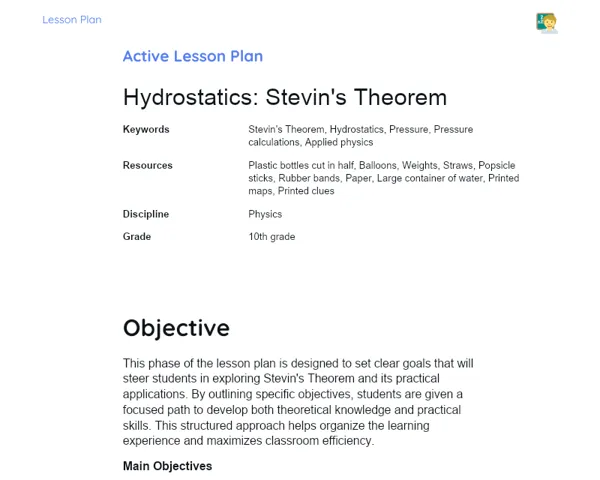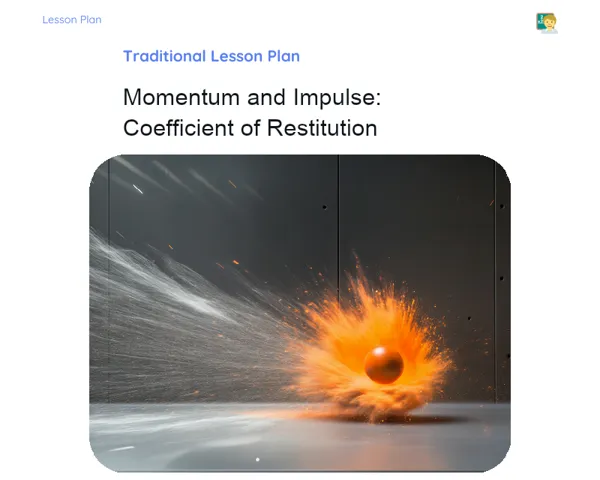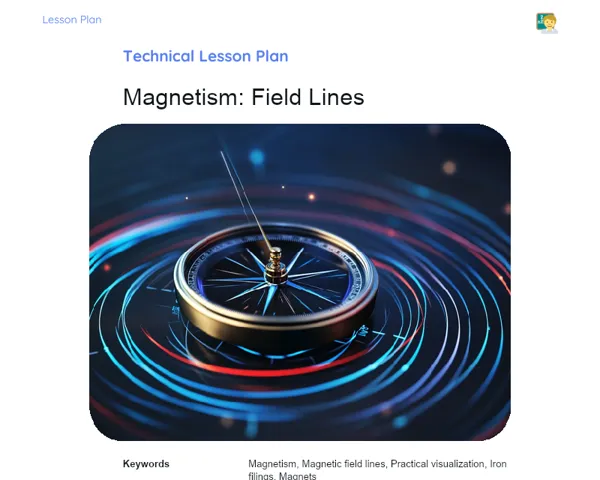Lesson Plan | Lesson Plan Tradisional | Geometric Optics: Prisms
| Keywords | Geometric Optics, Prisms, Snell's Law, Angular Deviation, Refraction, Light Dispersion, Isaac Newton, Binoculars, Optical Instruments, Practical Problems |
| Resources | Whiteboard, Markers, Projector or digital board, Presentation slides, Glass prisms, Light source (laser or flashlight), Scientific calculators, Printed exercises and problems, Ruler and protractor, Paper for taking notes |
Objectives
Duration: (10 - 15 minutes)
The aim of this stage in the lesson plan is to provide a clear and concise overview of the main objectives students should accomplish by the end of the lesson. This helps in guiding the class in an organized and focused manner, ensuring that students grasp the essential concepts of Geometric Optics related to prisms and build their practical skills in applying Snell's law and solving problems.
Objectives Utama:
1. Explain the concept of prisms and how light behaves when it passes through them.
2. Teach students how to apply Snell's law to calculate angular displacement in prisms.
3. Solve practical problems related to how light beams deviate when passing through prisms.
Introduction
Duration: (10 - 15 minutes)
🎯 Clarify the purpose of this stage. The introduction is designed to contextualize the lesson theme for students, igniting their interest and curiosity. By setting the scene and sharing intriguing facts, students will feel more engaged and ready to grasp the more complicated concepts that will come up later in the lesson.
Did you know?
🔍 Engage students with an interesting fact. One notable use of prisms in real life is in optical instruments like binoculars and periscopes, where prisms help bend the light path to allow viewing from different angles without shifting the instrument. Additionally, Isaac Newton’s famous experiment demonstrated that white light comprises several colours, using a prism to showcase this phenomenon.
Contextualization
👨🏫 Start the lesson by explaining the concept of prisms. Prisms are essential geometric shapes in Geometric Optics. They consist of two congruent and parallel polygonal bases, with lateral faces that are parallelograms. In optics, prisms are crucial for bending and breaking down light, separating it into its component colours. This phenomenon, called dispersion, is vital for understanding how light interacts with various materials.
Concepts
Duration: (40 - 50 minutes)
🎯 This section aims to deepen students' understanding of Geometric Optics concepts related to prisms. By covering the specific topics and solving practical questions, students will learn to apply the theory, use Snell's Law to calculate angular deviations, and comprehend light dispersion. This also helps develop analytical and practical skills necessary for solving optical problems.
Relevant Topics
1. Characteristics of Prisms: Discuss the geometric properties of prisms, including their parallel bases and parallelogram-shaped lateral faces.
2. Refraction of Light: Explore the idea of refraction, which is how light changes direction when moving from one medium to another, and its application in prisms.
3. Snell's Law: Explain Snell’s Law (n1 * sin(θ1) = n2 * sin(θ2)), detailing how it connects the angles of incidence and refraction with the refractive indices of the materials involved.
4. Angular Deviation: Teach how to calculate the angular deviation of a light beam as it passes through a prism, using Snell's Law.
5. Dispersion of Light: Discuss how different wavelengths of light are refracted at different angles while passing through a prism, leading to color separation.
6. Practical Applications: Share examples of how prisms are used in everyday optical devices (binoculars, periscopes, spectrometers) and reference Newton's experiment.
To Reinforce Learning
1. Calculate the angular deviation of a light beam entering a glass prism (n = 1.5) with an angle of incidence of 30° and emerging with an angle of refraction of 45°.
2. A white light beam hits a glass prism at an angle of incidence of 40°. What is the angular deviation for red light (n = 1.52) and blue light (n = 1.53)?
3. Explain the role of prisms in binoculars in bending the light path and enabling viewing at various angles.
Feedback
Duration: (15 - 20 minutes)
🎯 This stage aims to review and reinforce the knowledge students gained throughout the lesson. By delving into the question solutions and urging students to share their thoughts, the teacher ensures that students fully understand the discussed concepts and can apply them effectively. Additionally, this segment fosters a collaborative learning atmosphere allowing students to express their interpretations and questions.
Diskusi Concepts
1. 📘 Question 1: Calculate the angular deviation of a light beam entering a glass prism (n = 1.5) with an angle of incidence of 30° and emerging at an angle of refraction of 45°. 2. To solve this, apply Snell’s Law: n1 * sin(θ1) = n2 * sin(θ2). 3. First, find the angle of refraction inside the prism: 4. n1 = 1 (refractive index of air), θ1 = 30°, n2 = 1.5 (refractive index of glass). 5. sin(θ2) = (n1 * sin(θ1)) / n2 6. sin(θ2) = (1 * sin(30°)) / 1.5 7. sin(θ2) = 0.5 / 1.5 = 1/3 ≈ 0.333 8. θ2 = arcsin(0.333) ≈ 19.47° 9. Now calculate the exit angle: 10. n2 = 1.5, θ2 = 19.47°, n1 = 1 (air). 11. sin(θ3) = (n2 * sin(θ2)) / n1 12. sin(θ3) = (1.5 * sin(19.47°)) / 1 13. sin(θ3) ≈ 0.5 14. θ3 = arcsin(0.5) = 30° 15. The total angular deviation is the difference between the entrance and exit angles. 16. Angular deviation = θ3 - θ1 = 30° - 30° = 0° 17. However, since refraction occurred inside the prism, the final calculation must consider summing the internal angles, resulting in a greater deviation. 18. 📘 Question 2: A white light beam strikes a glass prism at an angle of incidence of 40°. Determine the angular deviation for red light (n = 1.52) and for blue light (n = 1.53). 19. For red light: 20. n1 = 1, θ1 = 40°, n2 = 1.52 21. sin(θ2_red) = (1 * sin(40°)) / 1.52 22. sin(θ2_red) ≈ 0.4224 23. θ2_red = arcsin(0.4224) ≈ 24.98° 24. For blue light: 25. n1 = 1, θ1 = 40°, n2 = 1.53 26. sin(θ2_blue) = (1 * sin(40°)) / 1.53 27. sin(θ2_blue) ≈ 0.4183 28. θ2_blue = arcsin(0.4183) ≈ 24.69° 29. The angular deviation will vary for each colour due to differing refractive indices. 30. Red angular deviation ≈ 24.98° - 40° = -15.02° (accounting for the path within the prism). 31. Blue angular deviation ≈ 24.69° - 40° = -15.31° (also considering the internal path). 32. These variations cause light dispersion. 33. 📘 Question 3: Explain how prisms are utilized in binoculars to bend the light path and enable viewing at different angles. 34. In binoculars, prisms invert the image and extend the focal length without increasing the device's size. 35. They redirect light through internal reflections, bending the light several times. 36. This design allows binoculars to remain compact while providing significant image magnification.
Engaging Students
1. ❓ What is the role of prisms in modern technology beyond the examples we've discussed? 2. ❓ How did Newton's experiments with prisms transform our comprehension of light? 3. ❓ What other optical phenomena can we explain using Snell's Law? 4. ❓ Are there any limitations in applying Snell's Law in the context of prisms? What might they be? 5. ❓ How can we observe light dispersion in everyday life besides rainbows?
Conclusion
Duration: (10 - 15 minutes)
The goal of this concluding section is to summarize and consolidate the important points covered during the lesson, reinforcing students' comprehension of the discussed concepts. By recapping the content, linking theory with practice, and underscoring the topic's significance, the teacher ensures students leave the lesson with a solid and applied understanding of what has been studied.
Summary
['The concept of prisms and their geometric attributes.', 'The process of light refraction and its implications for prisms.', "An understanding of Snell's Law and its relationship to incidence and refraction angles.", 'The calculation of angular deviation for light beams traversing prisms.', 'The phenomenon of light dispersion leading to color separation.', "The practical applications of prisms in optical devices and Newton's experiments."]
Connection
This lesson aligned theoretical concepts with practical applications by covering fundamental ideas in Geometric Optics and applying them to real-world problems. For instance, by calculating the angular deviation of light beams using Snell's Law, students could observe how theoretical formulas play out in observable outcomes.
Theme Relevance
Understanding prisms is significant for students in their daily lives, as it relates to practical uses in various modern technologies, including binoculars, cameras, and scientific tools. Moreover, grasping the concept of light dispersion and colors is vital for multiple branches of science and engineering, impacting everything from optical device design to the study of natural effects like rainbows.



